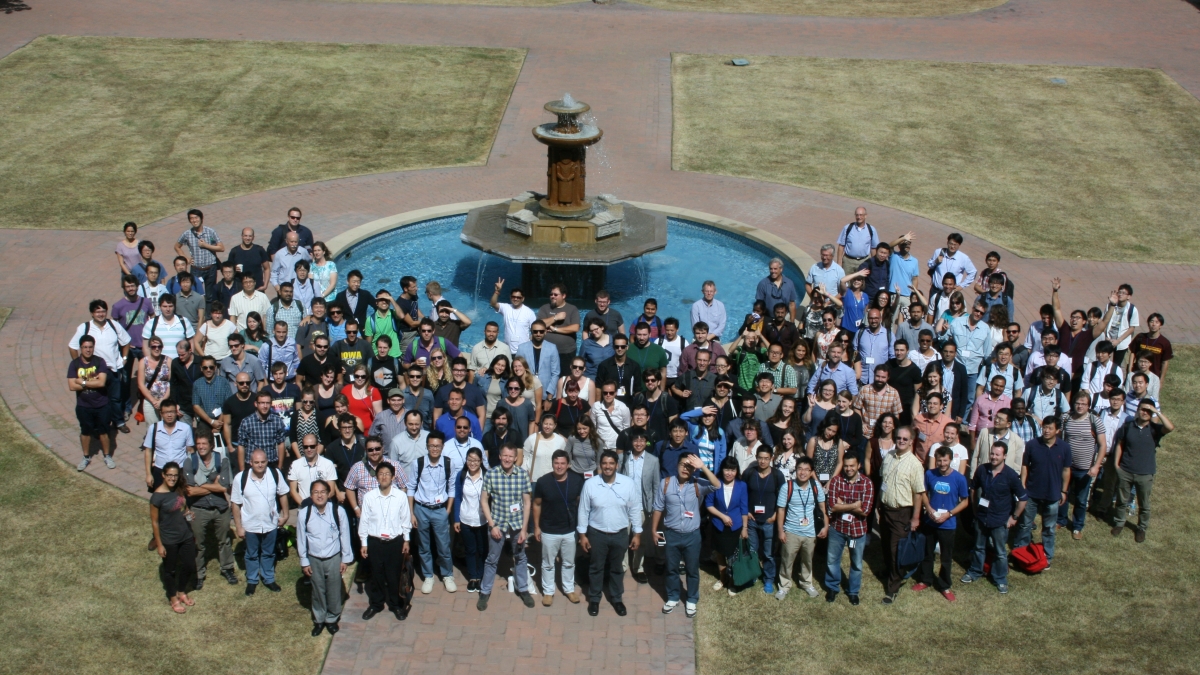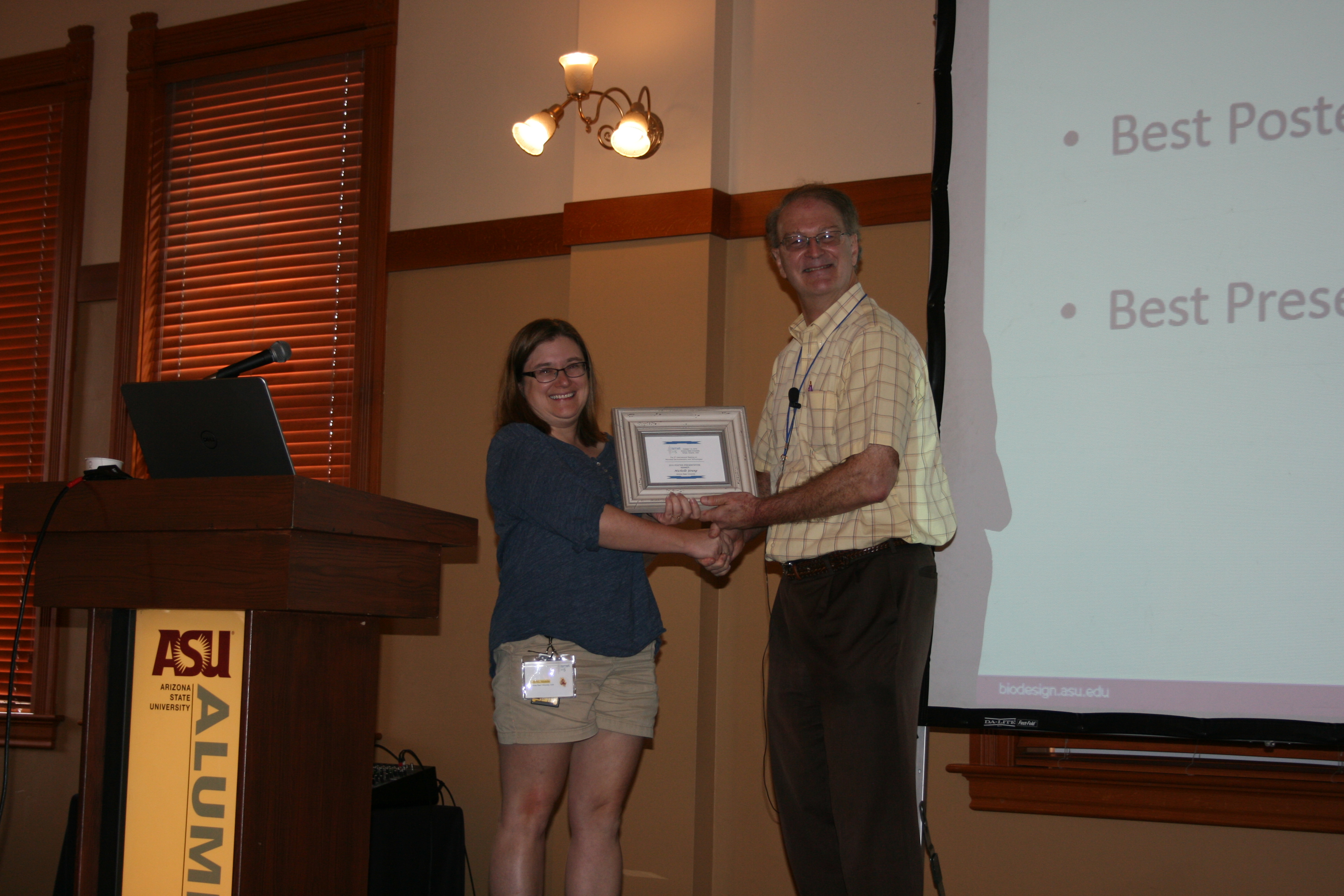Microbial managers converge at ASU for international conference

Attendees of ISMET2015, photographed from the steps of ASU’s Old Main, where many of the conference’s lectures were held.
Photo by: The Biodesign Institute
Arizona State University’s Tempe campus transformed into the epicenter of the microbial electrochemistry community for four days when it hosted the 5th International Meeting on Microbial Electrochemistry and Technologies (ISMET2015) from Oct. 1-4.
The event featured the diverse aspects of a dynamic new field in which the electrochemical properties of microscopic life are utilized in solving a range of human challenges, including wastewater treatment, the generation of clean electricity and the production of useful compounds. Lecture proposals flooded in from 20 countries, including Japan, Belgium and Saudi Arabia.
Cesar Torres, an assistant professor at ASU’s School for Engineering of Matter, Transport, and Energy, was this year’s organizing chair for the event. Torres is also part of the Biodesign Institute’s Swette Center for Environmental Biotechnology, under the direction of Bruce Rittmann, who holds the Regents’ Chair at ASU’s School of Sustainable Engineering and the Built Environment.
This year’s conference marks the return to the U.S. for ISMET, after successive conferences in South Korea, the Netherlands and Australia. Rittmann attributes the honor of hosting this year’s meeting to the innovative spirit at the Swette Center and groundbreaking advances in the field made at ASU.
Summit gets started after two years in the making
The conference kicked off Thursday, Oct. 1 at the Biodesign Institute with a pair of workshop sessions. The first concerned molecular biology and bioinformatics tools, while the second covered techniques in mathematical modeling and featured a talk by Swette Center professor Andrew Marcus.
The conference shifted into high gear following the workshops and moved to the oldest structure on campus — the Carson Ballroom at ASU’s historic Old Main building. Torres introduced the formal start of the conference with welcoming remarks and encouraged attendees to expand their professional horizons and interact with conference participants outside their immediate fields of expertise.
Torres also took the opportunity to thank event co-sponsors ISMET, the Office of Naval Research, Science and Technology, and the National Science Foundation. His remarks were followed by a warm welcome from president of ISMET Korneel Rabaey, professor of Belguim's Ghent University in the Department of Biochemical and Microbial Technology.
The first session began with a lively series of talks that focused on aspects of microbial fuel cell (MFC) technology, an overarching theme of the conference. These devices use the ability of microorganisms to acquire electrons from organic sources, transport them over distance and release them.
Bruce Logan of Pennsylvania State University gave the first plenary lecture describing the challenges of scaling up the technology for commercial use. Daniel Bond of the University of Minnesota, in another plenary lecture, described the still-enigmatic process of electron transport in Geobacter , one of the more popular bacteria used in MFCs.
Efficient electron transport is central to the viability of MFC technology, and though researchers have had considerable success generating electricity, the final word on how bacteria accomplish this feat remains a topic of aggressive investigation.
“These organisms are so efficient at what we call extracellular electron transport,” Rittmann says. “If you compare the size of the cell to the distance an electron travels, it’s like a football quarterback throwing the touchdown pass — except he throws it from one goal line to the other goal line on the fly, and he always completes the pass.”
Theory and practice
The conference was divided into eight technical sessions, four of which dealt with theoretical investigations including electron transport and optimal growth conditions for anode-respiring bacteria and four that addressed practical applications for MFC technology, including microbial desalinization and electrosynthesis.
Torres emphasized the reversible reaction of organics to electricity (or electricity to organics) as central to the discipline. “You can convert waste or some other high concentration organic feed into electricity or you can take electricity and produce an organic compound,” he said. “That's why we need the bacteria — to catalyze that interface.”
Following Thursday’s round of talks, attendees returned to the Biodesign Institute for an animated evening reception.
Days two and three of the conference saw wide-ranging talks delivered in parallel sessions. International contributors delivered lectures in the Arizona and Turquoise ballrooms of ASU’s Memorial Union throughout the day. Friday morning began with a stimulating lecture by Sahand Pirbadian from the University of Southern California, whose talk was accompanied by video clips of the bacterium Shewanella oneidensis in action. Later in the same session, Bradley Lusk of the Swette Center presented his research on anode respiration as a function of pH and buffer concentration.
Additional highlights included two engaging sessions where over 120 scientific posters were showcased and discussed. Saturday’s conference dinner was held in the Memorial Union’s Ventana Ballroom.
The conference provided an ideal forum for informal exchanges among participants, fostering many intriguing discussions across the scientific disciplines of biology, electrochemistry and engineering. Social media kept both attendees and the wider world abreast of conference developments, with a flurry of Twitter postings monitoring lecture highlights, contentious discussions and the more lighthearted moments of the gathering.
All good things must end
After unseasonably warm temperatures at the start of the conference, nature brought relief to the desert in the form of rain showers on Sunday. In addition to cooling things off, the welcome precipitation helped underline Xia Huang’s morning lecture on water desalinization, nutrient recovery and the increasing water crisis facing the planet.
At the close of ISMET2015, attendees heard from ISMET president Rabaey, who spoke on the usefulness of electricity as a driver of microbial processes. Professor Rittmann then delivered the conference’s closing remarks, followed by an awards ceremony honoring top posters and best lecture presentation. Winners of the top poster award were Fernanda Jimenez (University of Minnesota), Michelle Young (ASU), Moshe Baruch (Lawrence Berkely National Laboratory) and Benjamin Korth (Helmholtz Center for Environmental Research – UFZ, Germany).
Michelle Young of Biodesign’s Swette Center for Environmental Biotechnology accepts an award from professor Bruce Rittmann for her poster: Microbial electrolysis cells (MECs) detect differences in waste-activated sludge pre-treatment technologies.
The conclusion of the conference featured tours to either of two quintessential Phoenix locations: the Phoenix Desert Botanical Garden, a dazzling 140-acre site featuring over 50,000 plants displayed in outdoor exhibits that highlighted the spectacular diversity of living forms native to the Sonoran Desert, or Taliesin West, architect Frank Lloyd Wright's winter home and school in the desert from 1937 until his death in 1959.
In a final tweet, Jon Badalamenti, who received his doctorate in microbiology from ASU in 2013 and delivered an opening workshop as well as a lecture on day 2 of the conference, captured the general mood of exhilaration and enthusiasm at this year’s gathering:
“I don't know about you but ISMET2015 has been one of the best meetings I've been to in recent memory - tons of cool science & great people!”
